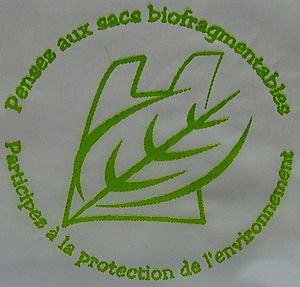Biodegradable bag facts for kids
Biodegradable bags are special bags that can break down naturally. Tiny living things like bacteria or fungi help them disappear over time.
Every year, people use a huge number of plastic bags, about 500 billion to 1 trillion around the world. These bags often stay in the environment for a very long time. Biodegradable bags are designed to help reduce this problem by breaking down more easily.
Contents
What's the Difference: Biodegradable vs. Compostable?
It's easy to get confused between "biodegradable" and "compostable." They sound similar, but they mean different things, especially for plastics.
What "Biodegradable" Means
When something is "biodegradable," it means it can be broken down by bacteria or other living organisms. This process turns the material into simpler, natural substances. However, "biodegradable" doesn't always mean it will break down quickly or in every environment. For example, a "biodegradable" bag might still take a very long time to break down in a landfill where there isn't much air or moisture.
What "Compostable" Means
"Compostable" is a more specific term. For plastics, it means the material can break down in a special place called a compost site. These sites have controlled conditions, like certain temperatures and humidity levels, and lots of air (aerobic environments). When a bag is truly compostable, it will break down into things like carbon dioxide, water, and natural plant material (biomass) at a similar speed to other things that are known to be compostable.
Oxo-Biodegradable Bags
Some plastic bags are made to be "oxo-biodegradable." These bags start as regular plastic, like polyethylene. But they have a special additive mixed in. This additive makes the plastic break down faster when it's exposed to air and sunlight. After the plastic breaks into tiny pieces, bacteria can then finish the job and break it down completely.
What Are Biodegradable Bags Made From?
Biodegradable bags can be made from different materials. Many are made from plant-based materials, like corn. For example, polylactic acid (PLA) is a common material made from corn starch. These bags are often just as strong as regular plastic bags.
Other biodegradable bags can be made from:
- Paper
- Other organic materials
- A type of plastic called polycaprolactone
It's important to know that the word "biodegradable" can sometimes be confusing. A scientist named Ramani Narayan once said that "biodegradable" is "the most used and abused and misused word" right now. This is because even if something is biodegradable, it might still break into tiny pieces that can harm the environment. For example, in places like the Great Pacific garbage patch, biodegradable plastics can break into small bits. These tiny pieces can then be eaten by animals, entering the food chain.
Can Biodegradable Bags Be Recycled?
Recycling biodegradable bags can be tricky. While the factories that make them can often reuse their own leftover pieces, it's harder to recycle them once people have used them.
Here's why:
- Contamination: Bio-based plastics can mix with and contaminate regular plastics during recycling. This makes it harder to recycle the regular plastics properly.
- Unknowns: For oxo-biodegradable plastics, there haven't been many long-term studies. This means recyclers don't always know how these additives will affect new products made from recycled plastic.
- Different Formulas: The special additives in oxo-biodegradable films can vary a lot. This makes the recycling process even more complicated.
Because of these issues, many places that recycle plastic films might not accept biodegradable bags.
Rules for Marketing Biodegradable Bags
Governments have rules to make sure companies are honest about their "biodegradable" claims. This is to stop people from being tricked into thinking a product is better for the environment than it really is.
In the United States, the Federal Trade Commission (FTC) has rules called the "green guide." These rules say that if a product is marketed as "degradable" or "biodegradable," the company must clearly explain how it breaks down. They need to say what conditions are needed (like sunlight or oxygen), how long it will take, and what the final results will be.
For example, if a trash bag says it's "degradable" but it's usually thrown into a landfill (where there's little air or moisture), the company needs to prove it will actually break down there. If they can't, the claim is misleading.
Some places have even stricter rules:
- In 2007, the state of California made it almost illegal to use the term "biodegradable bags" unless companies had strong proof to back up their claims. This was to prevent misleading consumers.
- In 2010, a company in Australia was fined for making claims about biodegradable bags that weren't true or clear enough.
These rules help make sure that when you see a bag labeled "biodegradable," you know exactly what that means for the environment.
Images for kids



